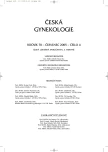Differences in the Polychlorinated Biphenyl Levels in Follicular Fluid in Individual Types of Sterility
Authors:
Simona Jirsová 1; J. Mašata 1; P. Drbohlav 1; J. Pavelková 1; L. Jech 2; M. Omelka 3; J. Zvárová 3
Authors‘ workplace:
Gynekologicko-porodnická klinika 1. LF UK a VFN, Praha, přednosta prof. MUDr. A. Martan, DrSc.
1; AXYS Varilab, s. r. o., Vrané nad Vltavou, vedoucí laboratoře RNDr. L. Jech, CSc.
2; Euromise Centrum, Univerzita Karlova a Akademie věd ČR, Praha, ředitel prof. RNDr. J. Zvárová, DrSc.
3
Published in:
Ceska Gynekol 2005; 70(4): 262-268
Category:
Original Article
Overview
Objective:
To find the differences of polychlorinated biphenyls (PCBs) levels in follicular fluid in different indications to treatment with IVF + ET program.
Design:
Pilot study.
Setting:
Department of Obstetrics and Gynecology, 1st Faculty of Medicine, Charles University and General Faculty Hospital, Prague, AXYS Varilab, s.r.o., Vrané nad Vltavou, Prague, Euromise Centrum, Charles University and Academy of Art, Prague.
Methods:
We examinated 100 infertile women undergoing IVF + ET program in our pilot study. After ovarian pick-up, frozen follicular fluid were transported to the laboratory. We detected the levels of polychlorinated biphenyls in follicular fluid of infertile women. The levels were compared according to the different indications of treatment. The control group consist of patients with male factor of sterility.
Results:
We confirmed the higher levels of PCB 114, 153, 156, 157, 180 and 189 in indication endometriosis compared with the others and with control group. The levels of PCBs were in ng/gram of fat.
Conclusion:
It has become apparent that higher levels of PCB 114, 153, 156, 157, 180 and 189 in endometriosis patients may be one of many factors participating in the origin of the disease.
Key words:
IVF + ET program, polychlorinated biphenyls, endometriosis, xenobiotics
Labels
Paediatric gynaecology Gynaecology and obstetrics Reproduction medicineArticle was published in
Czech Gynaecology

2005 Issue 4
Most read in this issue
- Prenatal Parvovirus B19 Infection in Fetus
- The Detection of p16 Protein in Uterine Cervix Lesions
- Changes in Vesicalization of Urethra and Bladder after TVT Operation
- Antibiotics prophylaxis in laparoscopy
